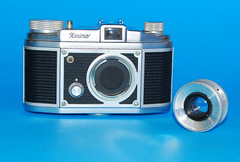Difference between revisions of "Finetta 88"
m (image-author templates for attribution) |
m (fixing Flickr clickthrough link) |
||
| Line 36: | Line 36: | ||
|} | |} | ||
{|class=plainlinks | {|class=plainlinks | ||
| − | ||[http://www.flickr.com/photos/heritagefutures/ | + | ||[http://www.flickr.com/photos/heritagefutures/4649475480/in/pool-camerawiki/ http://farm5.static.flickr.com/4043/4649475480_3af9a33c92_m.jpg] |
||[http://www.flickr.com/photos/heritagefutures/4649474714/in/pool-camerawiki/ http://farm5.static.flickr.com/4021/4649474714_68bf07aceb_m.jpg] | ||[http://www.flickr.com/photos/heritagefutures/4649474714/in/pool-camerawiki/ http://farm5.static.flickr.com/4021/4649474714_68bf07aceb_m.jpg] | ||
|- | |- | ||
Revision as of 18:20, 28 November 2011
| Finetta 88 |
|---|
|
Manufacturer: Saraber
Film type: 35mm
|
Introduced in 1953, the Finetta 88 was produced by Saraber/ Finetta Werke in Goslar (Germany) and also imported to Australia by Hanimex rebadged as 'Hanimar'. It has a lightweight aluminium body with a completely removable back. The camera is known with grey and black covering. The Finetta 88 has with exchangeable lenses via a simple bayonet. Three lenses were available: Finetar 4/43, Finetar 2.8/45, and Finetar 6.3/70.
To ensure that the film plane remains flat, the camera has a flip-up pressure plate attached to the body, rather than the standard spring-loaded plate attached to the back. Film-advance is by spindle, which also tensions the shutter. Auto-stop on film-advance. To re-wind, the film-advance knob is lifted which disengages a ratchet and pawl mechanism.[1]
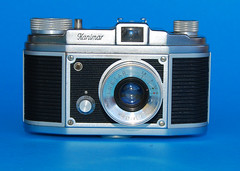
|
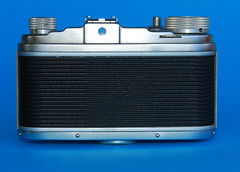
|
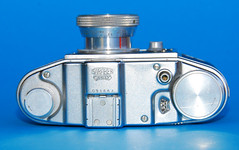
|

|

|
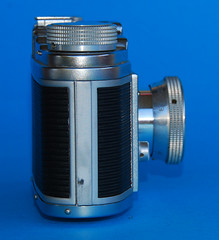
|

|

|
| Hanimar / Finetta 88 images courtesy Dirk HR Spennemann (Image rights) | |
Notes and References
- ↑ Amateur Photography 1 Jul 53, p. S4.; 6 Jun 56, p. S3.; 30 Jun 54, p. 45.
